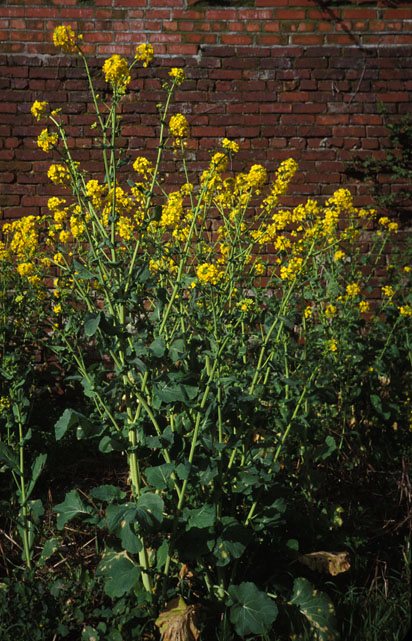
|
| Field Mustard; Brassica Rapa var. campestris |
Mustard Family; CRUCIFERÆ (BRASSICACEÆ)
|
| Field Mustard is an annual or biennial herb with much the same general nature as have common Radishes when they're allowed
to go to seed. In fact, it is the wild ancestor of Turnip, Rutabaga and some Kales. Nobody here or in Europe (whence it came) seems to
go out of their way to cultivate it, but many harvest it because few weeds are such truly excellent "wild vegetables." |
| It grows best in conditions suiting domestic salad crops: rich, loose, moist soil and more than a little sunshine. Usually seedlings
sprout in fall, grow hardily through winter, developing a thick white root and a clump of dark, rough, raspy, lobed leaves quite like those
of Radishes. Then a flowerstalk ascends 1 to 6 feet tall, stout or slender according to the vigor of the plant, growing less rough and more
smooth as it increases and branches. The leaves on it are smaller, clasping, and somewhat pale with a thin powder or
bloom. Intense, beautiful bright yellow flowers one-half to three-forths of an inch wide are very conspicuous from mid-March until June, with sporadic ones thereafter
if enough moisture remains in the soil. Beaked seedpods, each one to three inches long, ripen a dozen or two seeds. |
| In late winter or early spring, mustard greens present one of the most valuable wild foods. Substantial, highly nutritious,
deliciously hot-flavored, they are top-notch added to salads, cooked, or juiced. Such keen concentration of flavor and nutrients makes an
eminently healthy, even shocking, addition to the diet. The seeds can also be harvested for use as a flavoring, or can be sprouted. The familiar
mustard sauce condiment of hotdogs and the like is made from seeds of a Field Mustard cousin: Black Mustard
(Brassica nigra): also wild in the Seattle area but less common in cities. |
Most weed and edible-plant books treat this species. Sometimes it is under the names given above, and other times as
Brassica Rapa L., or under one of its alternate English names: Yellow Mustard, Wild Mustard, Wild Turnip, Wild Kale, Bird Rape, Navew, Cale. It
can hybridize with cultivated Brassica crops and some such offspring are in turn cultivated
(e.g., canola oil plant), while other strains
are considered weeds. Thus, at least to city-dwellers, this weed is more of an attractive, useful wild vegetable than it is a serious or
undesirable pest. Farmers may rightly condemn it when it invades their fields. In any case it deserves knowing.
|
Originally published as the Seattle Tilth newsletter Weed of the Month in October 1987, along with an illustration drawn by Jerri Geer.
Back |
|
|

